
by Lori Berson | Dec 12, 2022 | artificial intelligence, Marketing
According to the latest Salesforce State of Marketing Report, there’s sustained growth in the share of marketers around the world who have a fully defined artificial intelligence (AI) strategy, reaching 68% this year from 60% last year and 57% in 2020.
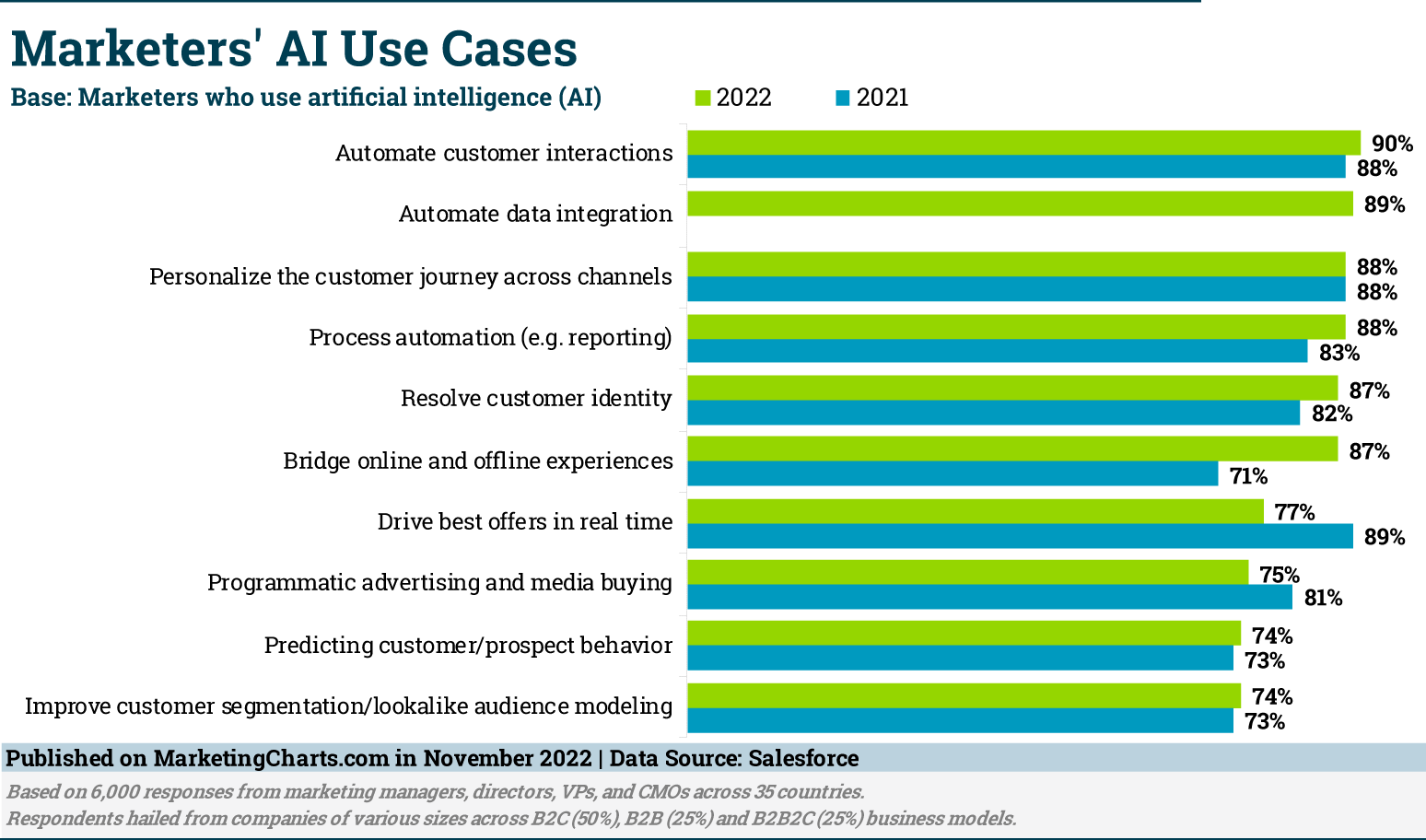
Among the marketing organizations that use AI, the most widespread use is to automate customer interactions, as reported by 90%. Some 89% use AI to automate data integration, while 88% use these applications to personalize the customer journey across channels, and an equal 88% for process automation, such as reporting. The analysts note that three of the top four AI use cases are related to automation, highlighting the importance of scaling up speed and effectiveness with existing resources.
The biggest year-over-year decline in AI usage is for driving the best offers in real-time (77% this year, down from 89% last year).
By contrast, the biggest jump this year has been in the percentage of AI users who are leveraging the technology to bridge online and offline experiences: 87% report doing so this year, up from 71% last year. This is interesting given the above findings on automation: past research has found that while automation can improve efficiencies, adding artificial intelligence (AI) can help to further improve the customer experience.
The study notes that marketers are leveraging AI to improve customer experiences, which is helpful based on marketers’ customer-centric focus. Eight in 10 respondents to Salesforce’s survey agree that customer experience is the key competitive differentiator. Despite some debate about who owns CX, marketers in this survey think that it’s their responsibility: 8 in 10 agree that their marketing organization leads customer experience initiatives across the business.
Marketers may be under pressure to make good use of AI: 88% either strongly agree (44%) or agree (44%) that marketers must continually innovate to remain competitive, and 71% also agree to some extent that meeting customer expectations is harder than it was a year ago.
Download Salesforce’s study to learn more.
About the Data: The results are based on 6,000 responses from marketing managers, directors, VPs, and CMOs across 35 countries. Respondents were from companies of various sizes across B2C (50%), B2B (25%), and B2B2C (25%) business models.
Need assistance with your marketing strategy? Schedule a call or email Lori Berson at lberson@BersonDeanStevens.com.
BersonDeanStevens has been a recognized brand strategy and marketing leader for over 25 years, including over a decade in marketing and sales automation. We work in partnership with you to differentiate your brand and achieve your business goals. Client list.
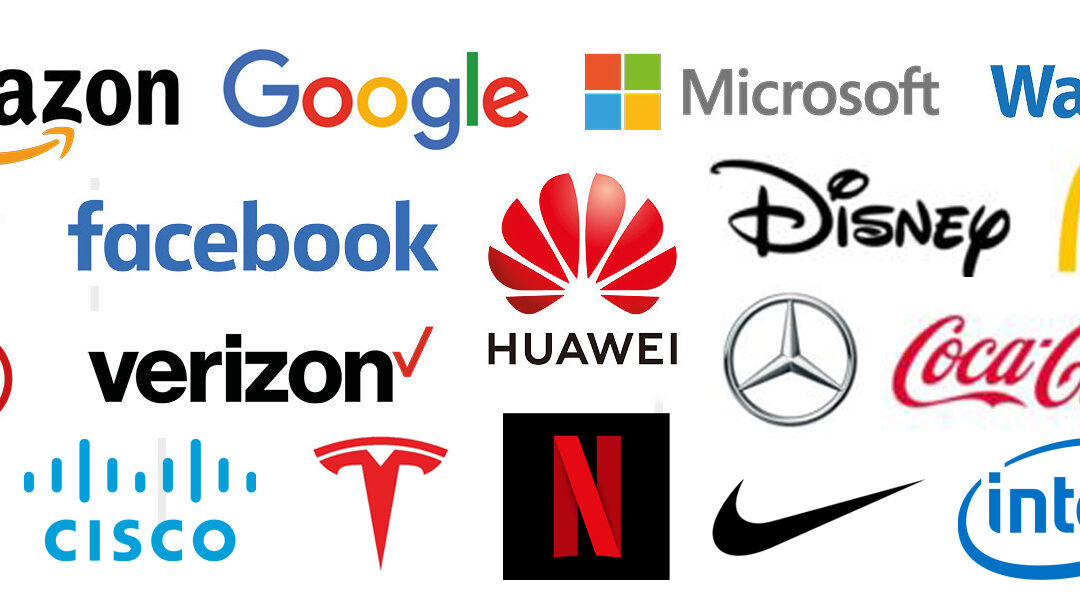
by Lori Berson | Dec 7, 2022 | Branding, Marketing
It’s no surprise that for the 10th consecutive year, Apple is the most valuable brand in the world, according to the latest annual Interbrand rankings.
This year, 9 of the top 10 brands experienced a year-over-year increase in their brand values, with Coke (#7) the exception, with a brand value that remained flat. Unlike last year, when only half of the top 10 brands had double-digit increases in brand value, this year each of those that grew (9 in total) showed increases of at least 10%.
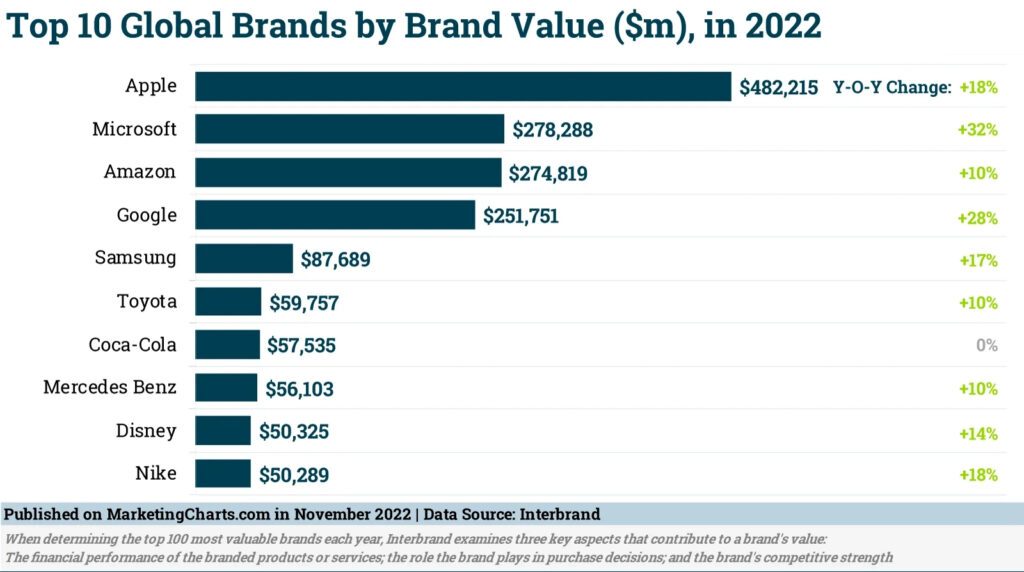
Apple’s (also the top brand in BrandZ’s rankings) brand value had an estimated value of $482 billion, up 18% from $408 billion last year. Next was Microsoft, which enjoyed the largest rise in brand value, up 32% to almost $279 billion. Microsoft jumped over Amazon, which fell to the third spot despite a 10% climb in brand value to almost $275 billion. Closing the gap with Amazon was Google, which remained in the fourth spot but which experienced a brand value rise of 28% year-over-year (to almost $252 billion), the second-fastest growth rate among the top 10.
There was then a steep drop-off to the fifth spot, held by Samsung (+17% to almost $88 billion). Each of the top five brands is a Technology brand, while the others rounding out the top 10 are from four different industries. The automotive industry is the next-most well represented in the top 10, with Toyota at sixth and Mercedes Benz staying at eighth. New to the top 10 this year was Nike, which overtook McDonald’s, which was ninth last year but fell to eleventh due to a smaller growth rate (+6%).
Overall, the top 100 brands recorded brand value growth of 16% year-over-year, the fastest rate ever recorded by Interbrand. They collectively now account for more than $3 trillion in brand value, exceeding that threshold for the first time.
Fastest-Growing and New Brands
As for the brands that saw the fastest growth in value over the past year, Microsoft was at the top with 32% growth, but it is followed closely by Tesla (+32%) and Chanel (+32%). Also following closely behind were Ferrari (+31%) and LEGO (+30%). Other fast risers this year included Google, Hermès, and Dior.
Three brands were new entrants to the top 100 this year – Airbnb, Red Bull, and Xiaomi.
For additional data and insights, download the report.
Need assistance with your branding? Schedule a call or email Lori Berson at lberson@BersonDeanStevens.com.
BersonDeanStevens has been a recognized brand strategy and marketing leader for over 25 years, including over a decade in marketing and sales automation. We work in partnership with you to differentiate your brand and achieve your business goals. Client list.

by Lori Berson | Aug 17, 2022 | Direct Mail, Marketing
According to survey results from Lob and Comperemedia, more than 7 in 10 consumers open direct mail either immediately or the same day they receive it, and 62% report having taken action after reading a direct mail piece.
And consumers most often visit a brand’s website after receiving a direct mail piece, so it’s critical to ensure every touchpoint in your campaign has consistent visuals and messaging to create an engaging customer experience optimized for conversion.
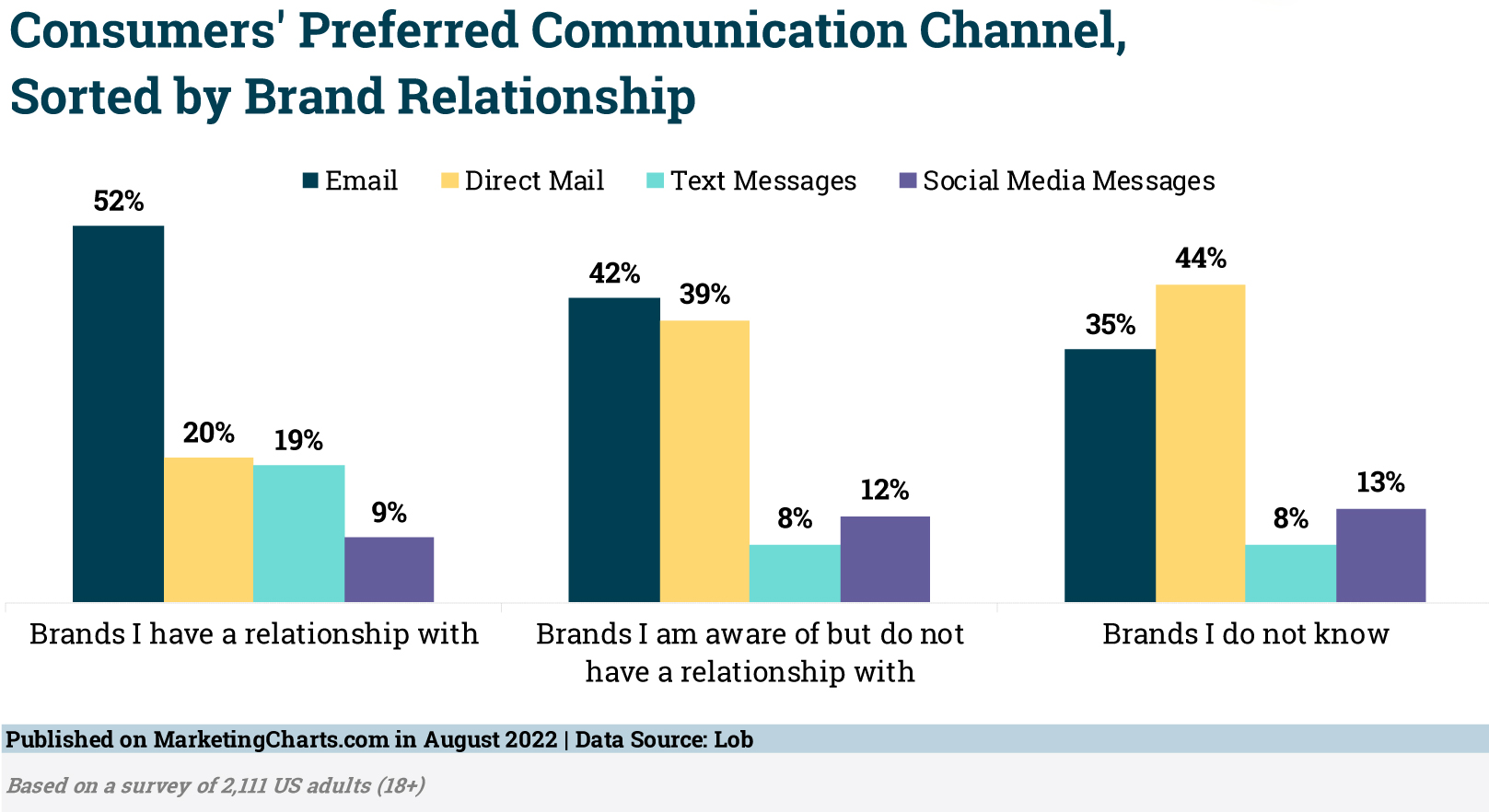
Key Findings and Insights
Direct mail is favored when customers don’t know the brand.
2,000+ US adults surveyed were given 4 channel choices (email, direct mail, text messages, and social media messages) and asked about their preferred communication from brands in different situations. For brands that respondents already have a relationship with, email was easily the preferred communication method (52%). Direct mail and text messages trailed distantly, but closely together (20% and 19%, respectively).
For brands that respondents are aware of but do not have a relationship with, the results showed email (42%) and direct mail (39%) as the preferred communication method. But for brands that respondents do not know, direct mail takes the lead (44%) ahead of email (35%), with social media messages (13%) and text messages (8%) trailing.
According to the results, direct mail can be an effective channel for customer acquisition. Indeed, consumers are receptive to direct mail, which can have lower-funnel impacts too: consumers rate it almost as highly as email for driving purchases.
Direct mail offers generate activity.
Promotions motivate action on social media and direct mail, per Lob’s report. The study finds that promotions and offers are the most important factors leading consumers to open or read a direct mail piece. 73% are likely to open or read a direct mail piece from a brand when it contains multiple offers or promotions, and 72% are likely to if it contains a single offer or promotion. Furthermore, offers and promotions are the leading reason for consumers to take action on a direct mail piece: among those who said they have taken action on direct mail, 64% said that it was because an offer or promotion caught their eye.
Although offers are the main driver, elements such as the design and copywriting as well as its personalization are important.
Catalogs and magazines are preferred.
Direct mail formats preferred from brands they know, respondents cited catalogs and magazines (53%) at the top of the list, ahead of brochures (pamphlet/booklet; 43%), letters and envelopes (39%), and postcards (33%). The study authors note that younger respondents (18-34) are considerably more likely than their older counterparts to prefer to receive letters and envelopes, while those ages 35-54 are the most likely to prefer to receive postcards.
Previous research has revealed that letter-sized envelopes sent from a prospect list have a higher ROI than those of oversized envelopes (92.2%), dimensional (92.3%), and postcards (85%) sent from a prospect list.
Need assistance with your direct mail strategy and production? Schedule a call or email Lori Berson at lberson@BersonDeanStevens.com.
BersonDeanStevens has been a recognized brand strategy and marketing leader for over 25 years, including over a decade in marketing and sales automation. We work in partnership with you to differentiate your brand and achieve your business goals. Client list.

by bersondev | Jun 7, 2022 | Marketing, marketing automation, marketing technology
Marketing automation empowers marketers to focus on the strategic initiatives rather than get bogged down with the tactical implementation, and it aligns sales and marketing towards accomplishing common goals. This all adds up to decreased costs and increased revenue.
Marketing Automation Features
Campaign and Email Management
Create and track highly targeted marketing campaigns. Manage end-to-end email campaigns, including database management, target list creation and segmentation, email personalization, and SPAM-compliant auto unsubscribe capabilities.
Website Search Engine Optimization
Connect with your customers early in the buying cycle with search engine-friendly pages.
Landing Page and Forms
Create dynamic landing pages and forms. Build reusable templates to create a consistent look and feel. Instantly create leads in your CRM system for immediate sales follow-up on all form submissions.
Lead Reporting and Analytics
Get comprehensive insight into your marketing programs by program type, lead source, and promotions — in real-time. Seamlessly track lead-to-revenue to measure the ROI of your lead generation programs.
“91% of the most successful users agree that marketing automation is ‘very important’ to the overall success of their marketing across channels.” —Ascend2
Marketing Automation Benefits
Effective Multi-Channel Campaign Management
Streamlines the execution of complex marketing campaigns across multiple channels, including websites, email, events, and social media with a centralized marketing platform.
Improves Sales Collaboration
Aligns marketing and sales goals to improve collaboration and convert leads into customers.
Shortens Your Sales Cycle
Delivers highly relevant dynamic content to prospects at the right time, right place and right channel, guiding them through the buying cycle.
Quantifies and Prioritizes Leads
Captures, identifies, scores and nurtures leads based on profile, behavior, interests, and conversion readiness to deliver sales-ready leads.
Real-Time Visibility
Provides insight into campaign performance and return on investment (ROI) with robust analytics.
To learn how to best use Marketing Automation to increase ROI, check out this article.
As a recognized Marketing Automation leader for the past decade, we work with firms to help them utilize their marketing technology to increase revenue. To see how we can help you, schedule a free consultation or email Lori Berson at lberson@BersonDeanStevens.com.
BersonDeanStevens has been a recognized brand strategy and marketing leader for over 25 years, including over a decade in Marketing Automation. We work in partnership with you to differentiate your brand and achieve your business goals. Client list.
![Marketers’ MarTech Stack Plans [Report]](https://bersondeanstevens.com/wp-content/uploads/2022/06/Martech-Tools-1080x675.jpeg)
by Lori Berson | Jun 4, 2022 | Marketing, marketing technology
According to an
Ascend2 report produced in partnership with Oracle, more than 8 in 10 marketers agree that they will have to add, remove, or replace components of their current marketing technology (martech) stack to improve performance this year.

Marketers continue to adjust their martech stacks in the hopes of getting better results, with 7 in 10 CMOs saying that they invested in a martech solution last year in order to improve their digital marketing performance.
Improving performance is the top-cited challenge by marketers, who also said that key marketing challenges include the ability to change/adapt to circumstances as they arise, and delivering an exceptional customer experience. Only 1 in 8 said that a poorly integrated martech stack is a challenge, with this at the bottom of the list of challenges.
Customer Data Platforms (CDPs) – Top Investment This Year
Recent research has suggested that more than half of marketers have adopted a customer data platform (CDP) in the past 18 months, and this survey likewise finds that these solutions are high on the priority list for marketers.
When asked which marketing solutions they plan to invest in the most this year, the B2B and B2C marketers surveyed pointed to CDPs (37%) first, followed by segmentation and targeting solutions (32%), email marketing platforms (32%), and testing and optimization solutions (30%).
Additionally, respondents were quick to point to CDPs as indispensable to their martech stacks. Some 36% cited them as a marketing solution they absolutely cannot live without, on par with email marketing platforms, and ahead of content management systems (32%), marketing automation platforms (28%), and testing and optimization solutions (25%).
The report points out that a CDP will help B2C marketers “make their social media efforts more effective and targeted,” as experimentation with new social platforms is a key marketing tactic that B2C respondents reported that they will add this year. On the list of new marketing tactics for B2C companies, this was second only to personalized content and offers.
B2B marketers also placed personalized content and offers at the top of their list of marketing tactics to add this year, with customer loyalty programs second (fourth on the list for B2C marketers). A sizable share will add video marketing efforts, with the report noting that B2B marketers are more apt than their B2C counterparts to make video editing software an investment priority this year.
Other Findings:
- Almost two-thirds of respondents (64%) said their marketing budgets are increasing from last year, versus one-quarter who said they’re decreasing.
- 88% either strongly (42%) or moderately (46%) agree that they will have access to the appropriate data to make critical marketing decisions, an almost identical result to previous Ascend2 research in which 84% responded either “yes” (29%) or “somewhat” (55%) when asked if they had enough data to make effective decisions on where to spend marketing and/or sales resources.
- If they could integrate data from another business application into their martech stack, the one that would have the most impact on their success would be customer service, followed by customer loyalty, according to B2B marketers. For B2C marketers customer loyalty edged out customer service.
- Customer purchase history is the first-party data source that will be most valuable to the broadest set of respondents in addressing the loss of third-party cookies.
- Trust in artificial intelligence (AI) is highest for targeting ads and personalizing content and offers in real-time, and lowest for writing subject lines and copy.
About the Data: The results are based on a January survey of 853 marketing professionals in management and leadership positions throughout the US, UK, Canada, and India. Respondents hailed from B2B (41%), B2C (24%) and both B2B and B2C (35%) companies.
Need help with your martech stack? Schedule a call or email Lori Berson at lberson@BersonDeanStevens.com.
BersonDeanStevens has been a recognized brand strategy and marketing leader for over 25 years, including over a decade in marketing and sales automation. We work in partnership with you to differentiate your brand and achieve your business goals. Client list.
![Most Widely Used Video Types Used by Marketers [Study]](https://bersondeanstevens.com/wp-content/uploads/2022/05/harrison-kugler-qNzLI82MAso-unsplash-1080x675.jpg)
by Lori Berson | May 25, 2022 | Marketing, Marketing Strategy, Video, Video Marketing
According to Vidyard and Demand Metric report, more than 8 in 10 marketing, sales, and customer experience executives say that video is becoming more important as a form of content in their organization
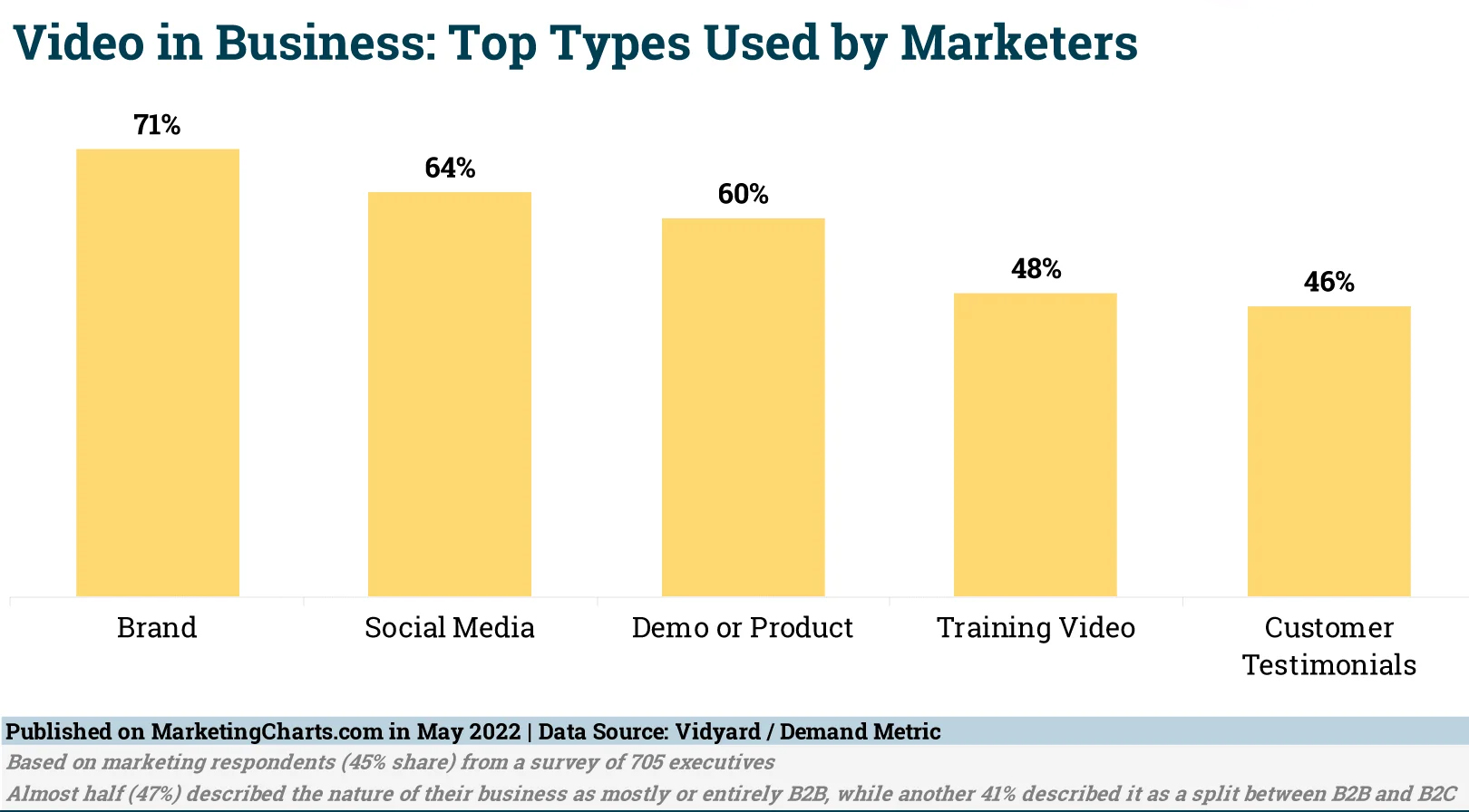
Overall Video Creation Increased 178% in 2021 Compared to 2020
Key Takeaways
1. Brand and Social Media Videos Are Widely Used by Marketers
The most common type of videos are brand videos (53%), followed by demo or product videos (51%), social media videos (48%), training videos (45%), and how-to videos (42%). The popularity of social media videos speaks to social’s presence as a leading distribution platform: 63% of respondents distribute videos on social media sites, equal with websites as the top area for posting videos.
80% of All Videos Created in 2021 Were User-Generated, Versus 60% in 2020
The top video types differ by role. For example, a large share of sales teams will invest in user-generated videos, while customer experience teams show a strong inclination to invest in how-to videos.
The Average Video Created in 2021 Was 9 Minutes and 58 Seconds Long
Among marketing respondents, the video types used by a majority are brand (71%), social media (64%), and demo or product (60%) videos, while close to half use training videos (48%) and customer testimonials (46%). Although how-to videos did not feature among the top 5 for marketers in this study, previous research indicates that they are often used by B2B content marketers, who find video to be among their most effective top-of-the-funnel demand generation tactics.
2. Half of The Marketers Say Video ROI is Improving
7 in 10 respondents across job roles said that video performs better than other content types they use or have used in producing their desired results, a figure 10 times higher than the share (7%) who say that video performs worse.
Additionally, two-thirds of respondents report that video’s ROI is either getting better (45%) or staying the same (21%), though 3 in 10 don’t know. Marketers are the most optimistic about video ROI, with about half (49%) saying that it is improving, and another fifth (21%) reporting steady results.
Prior research suggests that videos have performed better than other content types such as long articles, livestreaming content, and podcasts, though fewer content marketers in that study found video to be as effective for them as virtual events and research reports, among others.
3. Video Viewing Data Deemed Important for Lead Scoring and Nurturing
Three-quarters of sales respondents believe that it would be important for the sales team to access video viewing data to qualify leads, engage prospects, or influence specific deals. Marketers largely agree, with two-thirds recognizing the importance of such data to lead nurturing efforts.
Currently, roughly 1 in 5 (21%) respondents say that their sales team uses video viewing data to a great extent to qualify leads, engage prospects, or influence specific deals, while about one-third say the sales team does so to a moderate extent (34%) and one-quarter (26%) to a slight extent.
Integration of this data would help, yet remains in its infancy: only slightly more than 1 in 3 respondents (36%) say that they have integrated video viewing data into their marketing automation platform (MAP) and/or customer relationship management (CRM) system, although another half (49%) claim that they are planning to integrate this data.
4. Video Production Proves Difficult
While various teams within the organization are requesting and creating video content, marketing has the biggest role to play, and is the only team that a majority identified as both requesting (63%) and creating (65%) this form of content.
Although most medium- and large-sized companies use external resources to some degree to aid in their video creation efforts, only a minority of smaller companies do so.
This could prove problematic, as video production is a challenging affair. When asked which barriers or roadblocks respondents are facing in successfully leveraging video to help achieve business goals, the top 4 (equally cited) all involved production to some extent:
- Producing professional quality video that represents the brand well.
- Having a strategy to drive video production.
- Allocating staff time and resources for video production.
- Producing videos that engage.
No wonder content marketers identified video as the number one type of content they would create if more resources were available to them.
Nonetheless, a majority of respondents are very satisfied (7%) or satisfied (49%) with the results they’re getting from their video efforts, with satisfaction rates much higher (67%) among those who use advanced metrics.
With this in mind, it’s perhaps not surprising that video was mentioned as the top area of investment for B2B content marketers this year.
About the Data: The results are based on a survey of 705 executives across marketing (45% share), sales (25%), customer experience (12%), and other (18%) job roles. Almost half (47%) described the nature of their business as mostly or entirely B2B, while another 41% described it as a split between B2B and B2C.
Need assistance with your video marketing? Schedule a call or email Lori Berson at lberson@BersonDeanStevens.com.
BersonDeanStevens has been a recognized brand strategy and marketing leader for over 25 years, including over a decade in marketing and sales automation. We work in partnership with you to differentiate your brand and achieve your business goals. Client list.







![Marketers’ MarTech Stack Plans [Report]](https://bersondeanstevens.com/wp-content/uploads/2022/06/Martech-Tools-1080x675.jpeg)

![Most Widely Used Video Types Used by Marketers [Study]](https://bersondeanstevens.com/wp-content/uploads/2022/05/harrison-kugler-qNzLI82MAso-unsplash-1080x675.jpg)
